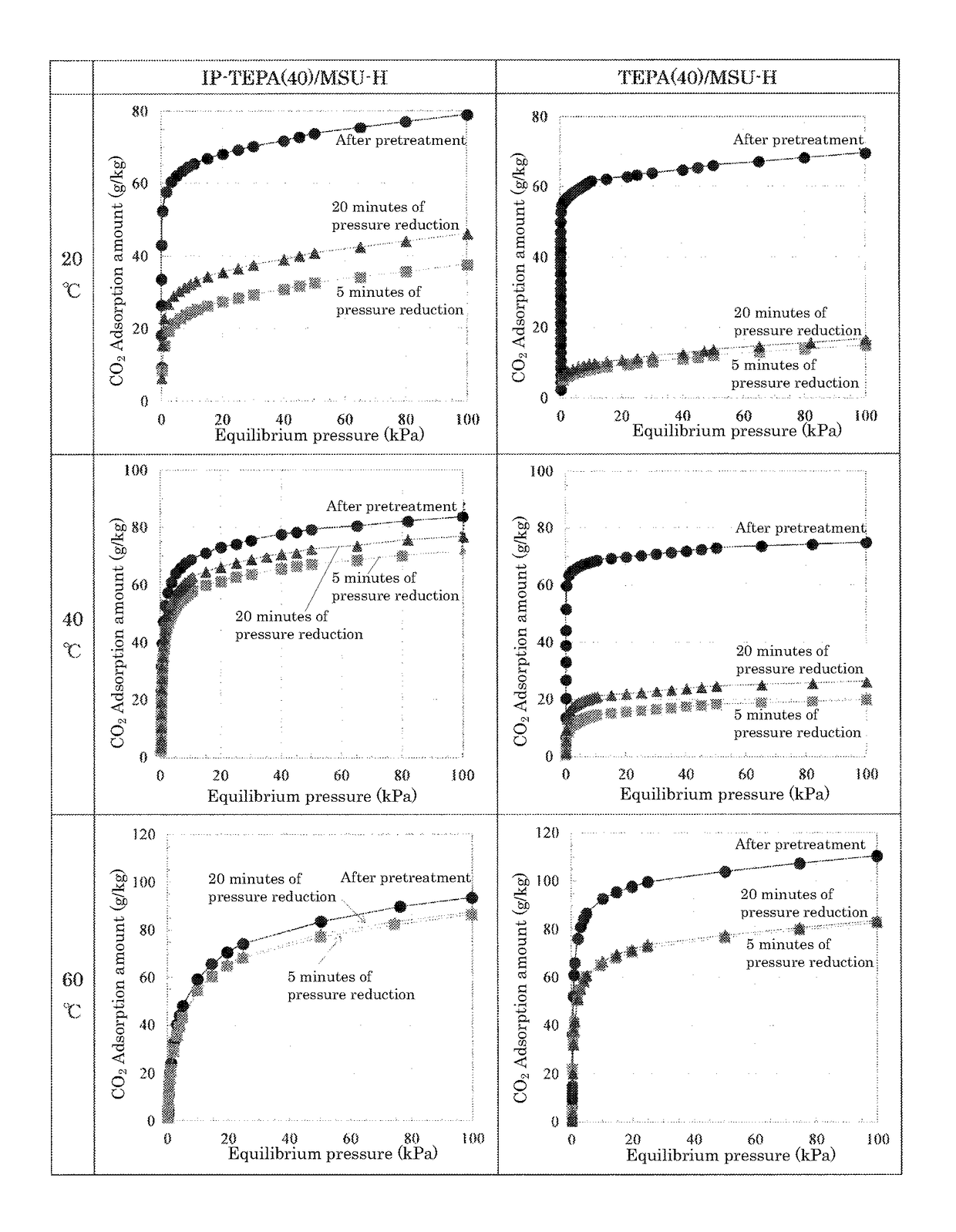Carbon dioxide separating material and method for separation or recovery of carbon dioxide
a carbon dioxide and separating material technology, applied in the field of carbon dioxide separating material and a method for separating or recovering carbon dioxide, can solve the problems of limited apparatus size, serious impact on agricultural production, and limited living environment, and achieve the effect of increasing the amount of carbon dioxide absorption, short-time pressure reduction, and separation and recovery of a large amount of carbon dioxid
- Summary
- Abstract
- Description
- Claims
- Application Information
AI Technical Summary
Benefits of technology
Problems solved by technology
Method used
Image
Examples
production example 1
Synthesis of Diisopropylated Tetraethylenepentamine (Hereinbelow Abbreviated as “IP-TEPA”)
[0090]IP-TEPA was produced as follows by modifying the synthesis procedure disclosed in J. Med. Chem. 1986, 29, 376-380.
[0091]1 mol of tetraethylenepentamine (TEPA) and a stirring bar were placed in a 2-L flask equipped with a reflux tube, and 2.0 mol of potassium carbonate dissolved in a trivial amount of water was added to the flask. While the flask was ice-cooled, the mixture was stirred, to which 400 mL of ethanol in which 2.0 mol of 2-bromopropane was dissolved was slowly added dropwise. After the completion of dropwise addition of the ethanol solution, the temperature of the flask was brought back to room temperature, and the reaction solution was stirred at room temperature for 36 hours. After the completion of the reaction was confirmed by liquid chromatograph mass spectrometer (LC-MS), water and ethanol were removed under reduced pressure at 40° C. to obtain a residue. Methanol was add...
production example 2
Synthesis of Diisopropylated Spermine (Hereinbelow Abbreviated as “IP-Spermine”)
[0094]25 g (0.12 mol) of spermine and a stirring bar were placed in a 500-mL flask equipped with a reflux tube, and 0.49 mol of potassium carbonate dissolved in a trivial amount of water was added to the flask. While the flask was ice-cooled, the mixture was stirred, to which 150 mL of ethanol in which 60.78 g (0.49 mol) of 2-bromopropane was dissolved was slowly added dropwise. After the completion of dropwise addition of the ethanol solution, the temperature of the flask was brought back to room temperature, and the reaction solution was stirred at room temperature for 36 hours. After the completion of the reaction, water and ethanol were removed under reduced pressure at 40° C. to obtain a residue. Methanol was added to the obtained residue, and insoluble matter was filtered off. Methanol was removed under reduced pressure to thereby obtain 29.42 g of IP-spermine as a colorless liquid (yield: 83).
[009...
production example 3
Synthesis of Tetraisopropylated N,N,N′,N′-Tetrakis(3-Aminopropyl)-1,4-Butanediamine (Hereinbelow Abbreviated as “IP-DAB-Am-4”)
[0097]25 g (78.98 mmol) of N,N,N′,N′-tetrakis(3-aminopropyl)-1,4-butanediamine (DAB-Am-4) and a stirring bar were placed in a 500-mL flask equipped with a reflux tube, and 0.316 mol of potassium carbonate dissolved in a trivial amount of water was added to the flask. While the flask was ice-cooled, the mixture was stirred, to which 100 mL of ethanol in which 38.86 g (0.316 mol) of 2-bromopropane was dissolved was slowly added dropwise. After the completion of dropwise addition of the ethanol solution, the temperature of the flask was brought back to room temperature, and the reaction solution was stirred at room temperature for 48 hours. After the completion of the reaction, water and ethanol were removed under reduced pressure at 40° C. to obtain a residue. Methanol was added to the obtained residue, and insoluble matter was filtered off. Methanol was remove...
PUM
| Property | Measurement | Unit |
|---|---|---|
| boiling point | aaaaa | aaaaa |
| specific surface area | aaaaa | aaaaa |
| specific surface area | aaaaa | aaaaa |
Abstract
Description
Claims
Application Information
 Login to View More
Login to View More - R&D
- Intellectual Property
- Life Sciences
- Materials
- Tech Scout
- Unparalleled Data Quality
- Higher Quality Content
- 60% Fewer Hallucinations
Browse by: Latest US Patents, China's latest patents, Technical Efficacy Thesaurus, Application Domain, Technology Topic, Popular Technical Reports.
© 2025 PatSnap. All rights reserved.Legal|Privacy policy|Modern Slavery Act Transparency Statement|Sitemap|About US| Contact US: help@patsnap.com



